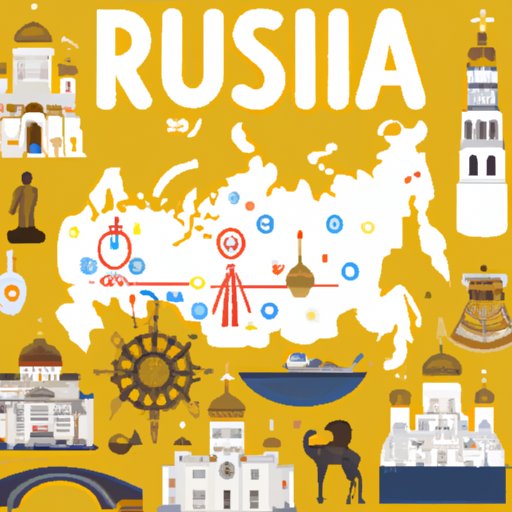Introduction
Have you ever wondered what the largest country in the world is? With its vast expanse of land, spanning two continents and eleven time zones, Russia takes the crown as the world’s largest country. In this article, we will explore the geographic, historical, and cultural aspects of Russia that make it such a unique and intriguing country. From the tundra to the taiga, join us on a journey through the world’s largest country.
From the Tundra to the Taiga: Exploring the Vast Territories of the World’s Largest Country
Russia’s geography is both varied and vast, encompassing a range of different climates and terrains. From the frigid tundra of the north to the temperate forests of the taiga, Russia boasts a diversity of landscapes that are unmatched by any other country.
Russia is divided into several distinct regions, each with its own unique features and attractions. The Central region, for example, is home to Moscow, Russia’s capital city, as well as other major cities like St. Petersburg and Nizhny Novgorod. Moscow is a bustling metropolis that is home to some of Russia’s most famous landmarks, including the Kremlin, Red Square, and St. Basil’s Cathedral.
The Southern region of Russia is characterized by its mild climate and fertile soil. Major cities in this region include Rostov-on-Don, Krasnodar, and Volgograd. The Black Sea resorts of Sochi and Anapa are also located in this region.
The Siberian region of Russia encompasses a vast swath of land that is home to some of the coldest and most desolate areas in the world. This region is dotted with small towns and cities like Krasnoyarsk, Norilsk, and Yakutsk, where temperatures can plummet to -50 °C during the winter months. Yet, despite these harsh conditions, Siberia is also home to stunning natural beauty, including Lake Baikal, the world’s deepest freshwater lake.
Size Does Matter: How Russia Became the Largest Country on Earth
So how did Russia become the largest country in the world? The answer lies in the country’s history, which is marked by a series of military conquests and territorial acquisitions. Russia began as a small principality centered around Moscow in the 14th century. Over time, it grew in size and power, eventually becoming a vast empire that stretched from Poland to Alaska.
The country’s size has been both an asset and a challenge throughout its history. On the one hand, its vast expanse of land has given it a strong strategic position, making it difficult for invading armies to conquer. On the other hand, this same size has made it difficult to govern effectively and has contributed to economic and political challenges throughout its history.
Beyond the Borders: Discovering the Cultural Diversity of the World’s Largest Country
One of the most fascinating aspects of Russia is its rich and diverse cultural heritage. Russia is home to over 190 different ethnic groups, each with its own unique culture and traditions. This cultural diversity is evident in the country’s food, music, dance, and art.
Perhaps the best-known aspect of Russian culture is its literature and music. Russia has produced some of the world’s greatest writers, including Leo Tolstoy, Fyodor Dostoevsky, and Anton Chekhov. Russian music is equally renowned, with composers like Tchaikovsky, Rachmaninoff, and Stravinsky among the most famous.
Other notable cultural traditions in Russia include the vibrant folk art of different regions, traditional dance forms like the Cossack dance, and unique customs like the maslenitsa festival, which celebrates the end of winter and the beginning of spring.
Breaking Down Boundaries: A Geographical and Historical Overview of Russia, the Biggest Nation in the World
The story of Russia’s formation and expansion is a fascinating and complex one. Over the centuries, the country has undergone a series of dramatic changes, shaped by wars, revolutions, and political upheaval.
One of the most significant events in Russian history was the Bolshevik Revolution of 1917, which led to the establishment of the Soviet Union. The Soviet period was marked by rapid industrialization and modernization, but also political repression and human rights abuses.
In the late 20th century, the Soviet Union began to unravel, and Russia emerged as an independent nation once again. Since then, the country has undergone a period of dramatic change, transitioning from a communist state to a market-based economy.
Making Sense of the Statistics: Exploring How Russia Measures up as the Largest Country in the World
When it comes to size, Russia is an impressive country. It spans nearly 18 million square kilometers, making it the largest country in the world by land area. However, size alone does not necessarily equate to power or influence in the global arena.
Despite its enormous size, Russia faces a range of challenges, including economic stagnation, political unrest, and demographic decline. Nevertheless, the country remains a major player on the global stage, owing in part to its size and strategic position.
Conclusion
In conclusion, Russia is a country that is full of contradictions. It is enormous in size, yet faces a range of political and economic challenges. It is home to a rich and diverse cultural heritage, yet has also been marked by political repression and human rights abuses.
Understanding Russia’s size and diversity is crucial for gaining a deeper appreciation of this fascinating country. Whether you are interested in exploring Russia’s natural beauty, its rich history, or its diverse cultural traditions, there is something for everyone in the world’s largest country.
